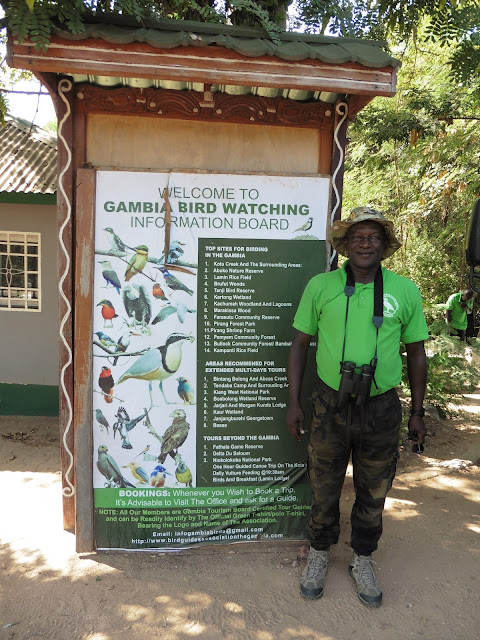There is a conflict at the heart of all tourism (and much else besides): are there benefits from a holiday that outweigh the carbon footprint of travel, air travel especially?
I’d like to describe some experiences from the recent (December 2022) Honeyguide Wildlife Holidays group in The Gambia, which I think show the good that can come from our kind of travel.
 |
| Gambia Bird Watching Society at Kotu Creek. |
On our first full day in The Gambia, we went to Kotu Creek. Here we met several enthusiastic members of the Gambia Bird Watchers’ Association. We heard about their work, particularly to protect and expand the mangroves of Kotu Creek. They were enthusiastic, articulate and inspiring, and very grateful for the support from our leader, Simon Tonkin, and through Honeyguide for their work. We saw mangroves planted and now growing well thanks to money sent from the previous Honeyguide group in 2018. These mangroves are valuable as a wildlife habitat, as a defence against erosion and are powerful carbon sinks – it’s said that they can store up to 10 times more carbon than forests.
 |
| Newly planted mangroves, upriver in The Gambia. |
 |
| 'Welcome to Farasuto Forest'. |
While based in Georgetown (Janjanbureh), we took a boat trip to Kunkilling Community Forest Reserve. This riverine forest by the Gambia river is known for Adamawa turtle dove, a very scarce species only discovered in The Gambia in 1990. A warden joined us and took us down the main track before we went into the wood, following the dove’s call – a purring like a low pitch turtle dove. We found it and had excellent views – possibly the best views that the warden had ever had, from the joy on his face when using our telescopes (a piece of kit he lacked). Again, we paid for the boat and the visit – all part of the process to continue protection.
 |
| Kunkilling Ecotourism Forest Park: welcome sign, arrival area, watching an Adamawa turtle dove. |
All these places, and others, survive by having visitors like us visit them. For us this was exploration as it should be, I think: we met people and engaged with them. Green tourism at its best.
That begs the question: what is ‘green tourism’ (also called ecotourism)? Greening is generally seen as a process rather than a precise end-point.
Coming up with a precise definition is tricky and it’s probably hard to improve on what Wikipedia says: ‘Ecotourism is a form of tourism involving responsible travel (using sustainable transport) to natural areas, conserving the environment, and improving the well-being of the local people.’ The ‘sustainable transport’ element is a moot point, of course.
For Honeyguide, examples of green tourism in practice include using locally-owned accommodation where possible, promoting understanding of wildlife and conservation issues and, especially, the conservation contribution included with every holiday. This has been at the heart of what Honeyguide does since we started more than 30 years ago.
Flights bought by Honeyguide are tiny in number and carbon footprint in the scheme of things. But we must acknowledge that the travel industry does, overall, have a big carbon footprint, especially from flights. Travel is not the only culprit: for example, the global fashion industry also has a massive carbon footprint. I hope it’s a compliment to say that a quick glance at a group of Honeyguiders suggests that we are well detached from the excesses of high street fashion!
Finding solutions is not easy. For us, buying the very best carbon offsets helps, of course. Running UK-based holidays without flights proved possible during the two years affected by Covid-19 lockdowns. Doing the same for overseas holidays is more challenging, often near-impossible. For wider policy issues, Friends of the Earth (here) summarises the issues.
What we do is not perfect. Put on a spectrum of travel ‘green-ness’, it’s certainly better than a lot of international travel. (Name your own examples … flying overseas to drink too much on stag/hen parties is one that comes to mind.)
My perspective is that we should continue to use travel as a force for good: protecting ecosystems, fostering understanding, encouraging sustainable practices, travelling as responsibly as we practically can.
Chris Durdin



